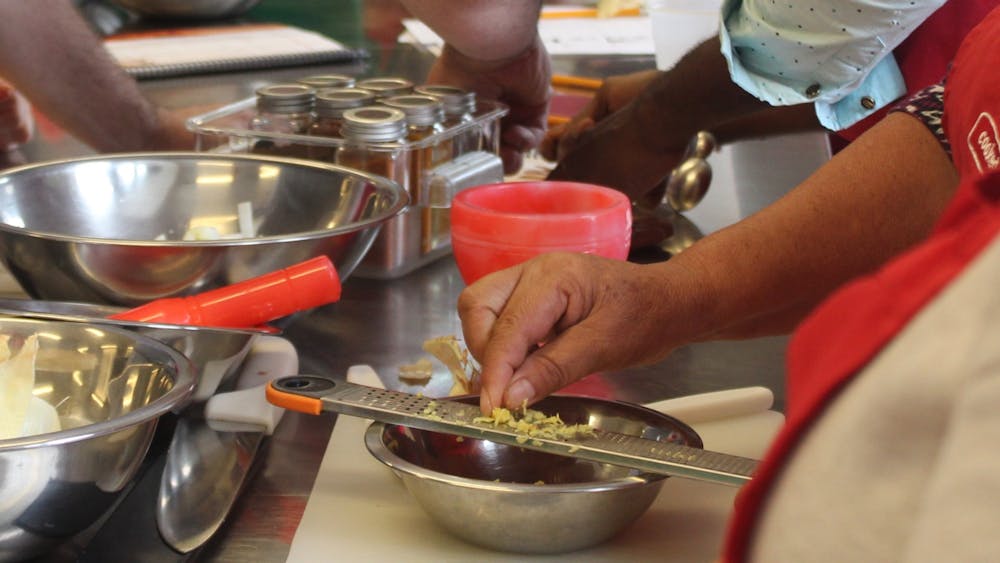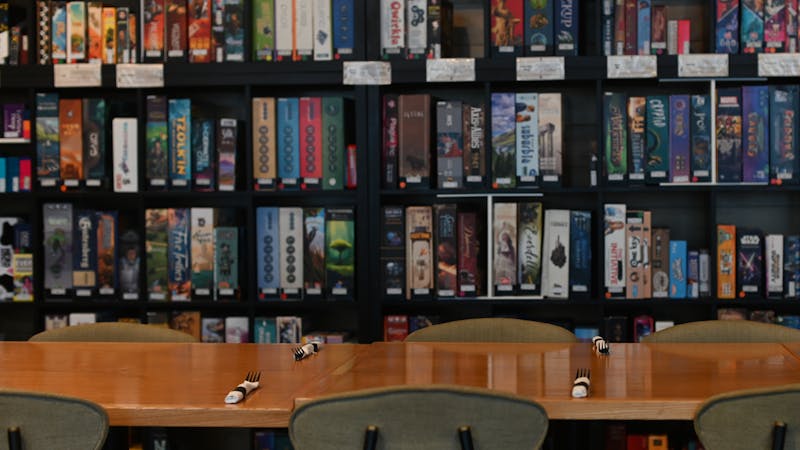Four floors up in the Philadelphia Parkway Central Library and accessible via a golden elevator ride is a large, industrial–looking kitchen. Lengthy metal tables line the room, rows of ovens and a plethora of sinks dot any open space, and a white board decorated with the various names of ingredients and scraps of recipes nearly covers an entire wall. This kitchen might be an unexpected feature if you’re used to the typical no–eating–or–drinking rules of a library. But the Parkway Central Library’s Culinary Literacy Center is the place to get messy with your food—it’s built for the mistakes that come with learning.
Celebrating its ten–year anniversary, the Culinary Literacy Center opened in 2014 with the hope of teaching culinary skills and building community. With a variety of programming, the center is welcoming to anyone of any age, with any skill level. All is offered for free, as is the tradition of a library.
Edible Alphabet, one of the programs of the center, invites all English learners to cook a meal while practicing the language. The program was born out of partnership between the Culinary Literary Center and the Nationality Service Center, an organization that aids immigrants and refugees.
“It was a one–off class,” program manager Lindsay Southworth explains. “They brought in a group of women who were survivors of torture to do a cooking English program.” That one–off class, however, quickly proved to have great potential. “They found that the sort of peace and joy that people get in the kitchen—cooking stuff together and connecting together—was really helpful for the participants in learning English and also for just feeling comfortable.”
Southworth came to the program six years ago, which has since grown from a single class to into its current more extensive program. Edible Alphabet is offered as a six–week course, with weekly three–hour classes held at the kitchen, as well as an 18–part, online series for those who can’t make it in person.
Every Thursday at 10:30 a.m., Philly residents across cultures with varying levels of cooking skills and experience with English walk into the Culinary Literacy Center’s kitchen. They leave with bellies full of home–cooked lunch, a new foray into the English language, and the beginning connections of a new community.
On the morning of Sept. 5, I took the SEPTA to Parkway Center Library, rode the golden elevators to the fourth floor, and unsuccessfully attempted to get into the kitchen—another student had to show me how to get in. Draped across each chair was a red or blue apron, and in front of each seat sat a thick white binder. We took our seats, filled out our name tags, and flipped through the pages of the binder. As 10:30 a.m. approached, more and more people trickled in. Some were greeted with excitement or knowingly glided to a clearly preferred spot. Others, like me, nervously stumbled to an open seat and stared wide–eyed at the open kitchen before us all.
By the time class started, the room was nearly full with about 25 participants.
This is the second class of this current six–week series. Of those in the kitchen with me, Southworth tells me that “probably two–thirds are returning, and one–third are new.” There are others still that have been taking this class for more than the general six weeks, with one person even coming for the last four years.
The class is inherently built around meeting people and making connections, as both the English and cooking lessons involve group work: Communication is key. “The conversation is often the biggest hurdle, but also the most important one,” Southworth says.
In one exercise, I turn to my partner to discuss our favorite bread. We have a bit of trouble understanding each other, as we’re both new to the class. I show her a photo of sourdough bread—my own favorite—and she nods, explaining that she always dislikes the thick crust. She talks of baking with her grandma and of bread with bruschetta. She, too, shows me a photo of her favorite bread—crostini, a crusty, thin breadstick.
Southworth leads the English instruction portion of class but works in tandem with a culinary chef to aid in cooking the meal. Today, we are making hummus and flatbread. Southworth describes the bread as thin and crispy. My partner nudges me. “Like Crostini,” she laughs. We learn various vocabulary about the ingredients, techniques, and tools used in the recipe, and we are then grouped and set free to cook.
I separate one egg white from the yolk for our dough, and one of my group members hands me the other egg. She tells me I did it so well, and that we need another for the egg wash. She also grabs a bowl to store the separated egg white until the right moment. Another member asks about kneading. I attempt to show it with our sticky dough. “Ah,” he says as he understands, and he then demonstrates how to properly knead dough. I accidentally add too much water and the one person who notices playfully tsks at me but wordlessly adds extra flour, as if it’s our little secret.
“When they’re laughing and making mistakes and putting too much salt in the dough,” Southworth says, “it just helps to relax their mind and help them to be more receptive to language learning and take more risks with communication.”
We eat lunch together, trying our own creations but also sharing with others. One girl warns me that our flat bread is just okay: not good, not bad. The guy who helped me knead makes a so–so motion, as I take a bite. I tell him I think it turned out pretty good, all things considered, and we laugh. The food is far from perfect, but by the time lunch is over, there are no leftovers.
As I gather up my belongings and help clean our station, those I met wave goodbye. One person tells me they hope to see me next week. By now, everyone is aware that I’m here with journalistic intentions, but they don’t shy away from including me. I walked into class expecting to be a passive observer, and I left feeling welcomed into a new community.
“We have a lot of people who have immigrated here recently. Some people may have been here longer, but many people are still rebuilding their social networks,” Southworth explains. “Probably just as important as the language learning is the connection to having people feel welcome and included.” The community here is certainly palpable; it’s warm and homey.
And it extends beyond the reaches of the Parkway Central Library’s kitchen. The Edible Alphabet program works to be accessible to all, not just those in the close vicinity. “The library system of Philadelphia is not just this library today, but 54 libraries across the city. We want to make sure that this class is accessible for people in neighborhoods where [the library doesn’t] have a fancy kitchen, but still have people to do cooking classes,” Southworth says. The program is adaptable so that it can move from library to library across the city, in hopes of breaking down any barriers for immigrants.
The class ends with a quick overview of the many services the library provides, a walk through of the easy process of obtaining a library card, and a brief tour of the library. Edible Alphabet—and the Culinary Literacy Center as a whole—is only one small facet of how the Free Library works to aid everyone in Philadelphia.
“We want people to leave this class feeling like they own the Library of Philadelphia. It is theirs to use and to share in the community.”






